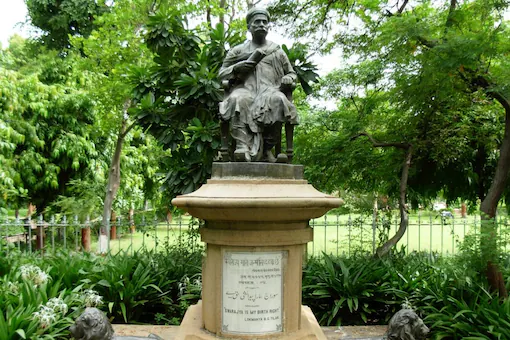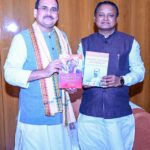Opinion | When Sardar Erected a Statue of Lokmanya
- By : Anirban Ganguly
- Category : Articles

The period between 1920-22, which saw the struggle to erect Lokmanya’s statue, was the period when Patel incessantly challenged the colonial government. Eventually, the statue was erected and unveiled in 1929
In his acceptance speech while receiving the Lokmanya Tilak National Award in Pune, Prime Minister Narendra Modi made a reference to Sardar Vallabhbhai Patel’s tenure as the Chairman of the Ahmedabad Municipal Corporation (AMC) and his struggle to erect Lokmanya Balgangadhar Tilak’s statue in Ahmedabad. It was an inspiring episode, like countless such episodes which are at times forgotten, at times marginalised, in the saga of India’s freedom struggle.
While PM Modi narrated that historic episode in his inimitable style, I went back to a very interesting book on Sardar Patel’s leadership of the AMC in the second decade of the last century. It is a time I had collected in one of my numerous intellectual peregrinations, its title, ‘Sardar Vallabhbhai Patel: from Civic to National Leadership’ instantly caught my attention. A detailed study of Sardar, the municipal leader, the work is perhaps one of its kind, published as early as 1980 and delves in great detail into Sardar Patel’s leadership of the Ahmedabad Municipality.
The author Devavrat N Pathak, then Vice Chancellor of Saurashtra University at Rajkot, was a scholar of political science and international relations and a well-known thinker on politics and Gandhi. But what was of interest to me was his co-author, Pravin Sheth, then a reader in political science at the University of Gujarat. A former University of Pennsylvania graduate, Sheth displayed remarkable scholarly insight into the study of Indian politics and its philosophy and practice. Sheth taught Narendra Modi, and years later, Modi as Prime Minister referred to Sheth as an “outstanding mentor.” When very few would have thought of exploring this dimension of Patel’s legacy and public work, Pathak and Sheth shed light on these very crucial years in Sardar’s life.
While Bardoli Satyagraha hammered and chiselled a “Sardar” out of Vallabhbhai, Patel’s years at the Ahmedabad Municipality brought out the leader-administrator in him. No detail was too small for him, no challenge and crisis unsurmountable and which could not be addressed through the Corporation. The overweening agenda, through all this, was the supremely national one — the struggle to free India. “Vallabhbhai’s is a case of a leadership,” the authors argued, “who displayed a good grasp of the emergent needs of the people of Ahmedabad, at the same time establishing and maintaining a live linkage with the broad national objectives of nation-building and the struggle for freedom.”
Patel’s association with the AMC lasted eleven years from 1917 to 1928, with a break from 1922-24 when the Municipality was taken over by the government. What is usually overlooked in most assessments of Sardar’s career, is the fact that he spent eleven active and successful years as a municipal leader, grappling with grassroots challenges, tackling basic issues affecting the daily lives of ordinary people and being politically active, leading the charge at one of politics most fundamental unit — the municipality. “These were the formative years of his career when he was merely Vallabhbhai Patel”, Bardoli and his honorific of “Sardar” was yet to come.
These eleven years, argue Pathak and Sheth, were “interspersed with numerous activities, often overlapping and intersecting one with the other, such as the ‘No-Tax Campaign of Kaira’, organising flood relief, attending to epidemics, tackling the Ahmedabad textile labourers strike, anti-Rowlatt agitation, non-cooperation movement and burning of foreign clothes, picketing foreign cloth and liquor shops, Congress sessions at Nagpur, Calcutta and Ahmedabad and the Borsad Satyagraha. Of these eleven years, Sardar headed the Municipality as Chairman for four years between 1924-28, establishing his undisputed stamp of a successful civic leader. These four years were the most fruitful of his municipal career and brought about increased and better amenities to the citizens of Ahmedabad.”
The period between 1920-22, which saw the struggle to erect Lokmanya’s statue was the period when Patel incessantly challenged the colonial government. It was “a period when the Municipality, under the able and astute guidance of Vallabhbhai, took to the path of non-cooperation”, leading the government to supersede the Municipality in 1924.
The Ahmedabad Municipality in Sardar’s hands became a “vibrant instrument” and he deftly and successfully “linked the micro with the macro-level of politics.” Throughout his tenure as Chairman, Sardar was seen turning each major issue and crisis into a people’s movement for melioration, mitigation and transformation. As Municipal Chairman, the authors noted, Patel’s “singular demonstration as a leader [was] evinced in his ability to convert the energy of the people into a real civic power — a reservoir of realisable and operational power, surcharged with a high sense of efficacy and self-conscious ability to translate goals into realities.” And along with Ahmedabad Municipality’s struggle against the colonial government, two other Municipalities in Gujarat, goaded by Patel — Nadiad and Surat — also put up an “equally valiant struggle.” This created “a great stir throughout Gujarat and instilled a new sense of political awareness along the entire of Central and Southern Gujarat.” Thus, Patel successfully used the platform of the municipality to stir nationalism.
Pathak and Sheth remind us of an interesting pattern in those early years. It was an interesting phase in Indian politics. Heredity or dynasty had not yet become normal or the trend, and leaders who would rise to towering prominence and would each become a pillar of the freedom struggle started at the municipal level. “These years saw several city municipalities presided over by upcoming national leaders”, C.R. Das in Calcutta, Vithalbhai Patel in Bombay, Nehru in Allahabad and Babu Rajendra Prasad in Patna. “But except for Vallabhbhai and Vithalbhai, none of these leaders either completed their terms or could administer their municipalities with much success.”
Both Vithalbhai and Vallabhbhai complemented each other in municipal-civic leadership. “Both were hardworking Chairmen, conducted business in the regional language, carried on various welfare activities and inculcated a new spirit in the entire administration.” While leaving “an indelible imprint of their personality and drive on their respective municipalities, both resigned almost simultaneously”, Vithalbhai towards the end of 1927 and Vallabhbhai in 1928.
In their masterly work, Pathak and Sheth mention in some detail the Lokmanya Tilak statue episode. It was in a board meeting on January 10, 1921, that Vallabhbhai first moved a proposal to erect a statue of Lokmanya Tilak. Tilak had passed away the previous year on August 1. Vallabhbhai’s proposal said that “in memory of the late Lokmanya Tilak, who worked tirelessly for independence, a statue of marble be erected in Victoria Garden at a place chosen by the Managing Committee and at the cost of Rs. 3,500/- to be spent from general fund; if anyone from among the people was to assist in this project, the Chief Officer be empowered to accept any monetary help that might come from the people for the sculpture.”
Moving the resolution, Vallabhbhai argued that “the proposed expenditure was a small amount and he hoped no difference of opinion would arise in connection with it.” The rub was also in his decision to erect Lokmanya’s statue in the city’s Victoria Garden! However, some loyalist members of the board and the Collector opposed the move. A good ten months later, the British Collector wrote back saying that “under the District Municipal Act, no such expenditure could be incurred, and, therefore, asked the Municipality not to spend any money.”
Vallabhbhai had naturally anticipated such a response and had got the Municipality to send a note to the Collector, even before he responded, asking whether such “expenditure had been incurred in the past. The reference was to a statue of Queen Victoria that was erected in 1908” and expenditure for which was sanctioned by the past Chairman with the government readily consenting to it. Despite this clear precedent, the Collector, caught off-guard, refused permission. Not one to give up, displaying a bullish tenacity, Vallabhbhai brought up the issue again when the General Board met towards the end of November 1921. He moved that the “Collector’s sanction was not necessary in regard to the erection of statue” and also that the board “reiterate its earlier resolution” and maintained that it was completely within the rights of the Municipality to spend money for this purpose. He referred to the public meeting that had taken place in the city to support the move and argued that the taxpayers had given their consent and had passed a resolution to that effect.
Rebutting those loyalists who questioned the legality of the move, Patel bluntly retorted that the “best way to decide about the legality or otherwise of the issue was to find out how and under what circumstances the expenditure of Rs 2000/- was made for erecting the statue of Queen Victoria. The Collector, the Commissioner and the Auditor all had given their consent…” In 1908, the Collector, Vallabhbhai reminded those who opposed the proposal, “had come forward and unreservedly given his consent for the expenses of Rs 2000/-. At that time, the Collector did not find any illegality about the expenditure. But in the year 1921, strangely enough, the expenditure for a similar purpose was being dubbed illegal…”
Against continuous and sustained opposition from the colonial dispensation, Vallabhbhai displayed an iron persistence for years. Eventually, the statue was erected and unveiled in 1929 by Mahatma Gandhi. It was a unique Tilak statue with a historic effort made behind it, an effort which symbolised the crystallised and intensifying urge for Swaraj, an effort which best expressed the essence and the substance of Sardar Patel.
In the same year — 1929 — when Sardar undertook an extensive tour of south India, addressing public and political meetings, and speaking on the many social and political challenges that India faced, many of Tilak’s old associates saw sparks of the Lokmanya in him. Tilak’s close associate and later Mahatma Gandhi’s follower, Gangadharrao Deshpande (1871-1960), referred to as ‘Khadi Bhageeratha of Karnataka’, who looked upon Tilak as his foremost political preceptor, hosted Vallabhbhai in Karnataka during this tour. Deshpande confessed that he “could hear the echoes of Tilak Maharaj in Patel’s frank language.” Rajaji felt the same way while Mahadev Desai had movingly expressed it in his 1928 assessment of Patel, “Vir Vallabhbhai” thus, “After watching his manner of speech, his smile and his laughter, his anger and his impatience, one cannot but be reminded of Tilak Maharaj…”
That afternoon in Pune, while accepting the Lokmanya Tilak National Award, PM Modi reminded us of this story — of Patel erecting the Lokmanya’s statue — a story of struggle and perseverance which embodied the ideals of a gigantic and epic struggle.
















